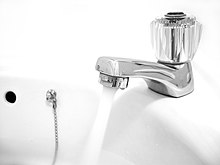**1. Water Sources and Quality:**
– Tap water is also known as running water, piped water, or municipal water.
– Piped water is considered an improved water source, along with boreholes, protected wells, rainwater, and bottled water.
– Sustainable Development Goal 6 includes piped water as an improved water source.
– Contamination of drinking water historically has been a significant health concern.
– Cloudy tap water is often caused by air bubbles and is not necessarily a sign of impurities.
– Bottled water may have fewer metal contaminants compared to tap water due to less exposure to plumbing pipes.
– Chlorine is often added to tap water as a disinfectant, potentially producing byproducts that can pose health risks.
– The residual chlorine concentration in tap water is regulated within safe limits.
**2. Water Supply Systems:**
– Fixtures and appliances in a building that use water can be categorized as fixtures or appliances.
– Waste/sewage components produced by consumption points need to be removed by the waste/sewage system.
– Public water supply systems are essential for functioning societies.
– Aspects of service quality include water continuity, quality, and pressure.
– The cost of water supply primarily consists of fixed costs.
– Water supply systems vary in responsibility, policy, and regulation across regions and countries.
**3. Plumbing Infrastructure and Maintenance:**
– Potable water supply systems consist of pipes, fittings, and valves.
– Different materials are used in constructing water supply systems.
– Modern plumbing systems deliver clean and potable water to taps.
– Mandates for water quality standards primarily focus on treatment plants.
– Factors within the distribution system can lead to tap water contamination.
– Lead pipes, once common, have been replaced due to health concerns.
– Backflow prevention methods and devices are crucial for maintaining water quality.
**4. Consumer Perception and Trust:**
– Majority of US households have access to high-quality tap water.
– Trust in tap water is influenced by governmental regulations on water quality.
– Health risks associated with tap water consumption influence consumer preferences.
– Severe violations of tap water standards decrease public trust.
– Debate exists on water quality differences between tap and bottled water.
– Some US municipalities prioritize tap water over bottled water.
**5. Legislation, Initiatives, and Research:**
– Various studies explore public perceptions of tap water and bottled water.
– Initiatives aim to reduce bottled water consumption.
– Outbreaks like Cryptosporidium in Milwaukee highlight the importance of water safety.
– UNICEF and WHO focus on household drinking water, sanitation, and hygiene.
– National Research Council assesses risks in public water supply distribution systems.
– Washington State repealed a bottled water tax via citizen initiative.
Tap water (also known as running water, piped water or municipal water) is water supplied through a tap, a water dispenser valve. In many countries, tap water usually has the quality of drinking water. Tap water is commonly used for drinking, cooking, washing, and toilet flushing. Indoor tap water is distributed through indoor plumbing, which has existed since antiquity but was available to very few people until the second half of the 19th century when it began to spread in popularity in what are now developed countries. Tap water became common in many regions during the 20th century, and is now lacking mainly among people in poverty, especially in developing countries.

Governmental agencies commonly regulate tap water quality. Calling a water supply "tap water" distinguishes it from the other main types of fresh water which may be available; these include water from rainwater-collecting cisterns, water from village pumps or town pumps, water from wells, or water carried from streams, rivers, or lakes (whose potability may vary).
